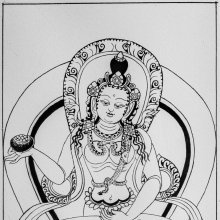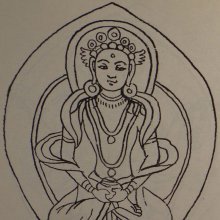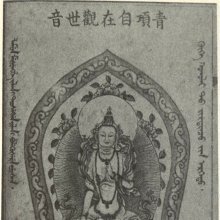Nilakanthalokeshvara, Nīlakaṇṭhalokeśvara, Nilakantha-lokeshvara: 1 definition
Introduction:
Nilakanthalokeshvara means something in Buddhism, Pali. If you want to know the exact meaning, history, etymology or English translation of this term then check out the descriptions on this page. Add your comment or reference to a book if you want to contribute to this summary article.
The Sanskrit term Nīlakaṇṭhalokeśvara can be transliterated into English as Nilakanthalokesvara or Nilakanthalokeshvara, using the IAST transliteration scheme (?).
Images (photo gallery)
In Buddhism
Tibetan Buddhism (Vajrayana or tantric Buddhism)
Source: archive.org: The Indian Buddhist Iconography1) Nīlakaṇṭhalokeśvara (नीलकण्ठलोकेश्वर) or simply Nīlakaṇṭha refers to one of the various forms of Avalokiteśvara having their Sādhana described in the 5th-century Sādhanamālā (a collection of sādhana texts that contain detailed instructions for rituals).—His Colour is yellow his Āsana is the vajraparyaṅka; his Mudrā is the samādhi; his Symbol is the ‘bowl of jewels’; his Companions are ‘two serpents on either side’.—One Sādhana only is devoted to the worship of this form of Lokeśvara, which is almost identical with that of Amitābha, his sire, whose image he bears on his head. Indeed, this mark of descent and the sacred thread he wears, constitute the only points of difference between them. Amitābha being a Dhyāni Buddha, has no father. Nīlakaṇṭha, according to the Sādhana, is accompanied by two serpents.
2) Nīlakaṇṭhalokeśvara (नीलकण्ठलोकेश्वर) or simply Nīlakaṇṭha refers to number 17 of the 108 forms of Avalokiteśvara found in the Machhandar Vahal (Kathmanu, Nepal). [Machhandar or Machandar is another name for for Matsyendra.]. [...]The names of the 108 deities [viz., Nīlakaṇṭhalokeśvara] possbily originate from a Tantra included in the Kagyur which is named “the 108 names of Avalokiteshvara”, however it is not yet certain that this is the source for the Nepali descriptions. Tibetan Buddhism includes schools such as Nyingma, Kadampa, Kagyu and Gelug. Their primary canon of literature is divided in two broad categories: The Kangyur, which consists of Buddha’s words, and the Tengyur, which includes commentaries from various sources. Esotericism and tantra techniques (vajrayāna) are collected indepently.
See also (Relevant definitions)
Partial matches: Lokeshvara, Nilakantha.
Full-text: Nilakantha.
Relevant text
Search found 1 books and stories containing Nilakanthalokeshvara, Nīlakaṇṭhalokeśvara, Nilakantha-lokeshvara, Nīlakaṇṭha-lokeśvara, Nilakanthalokesvara, Nilakantha-lokesvara; (plurals include: Nilakanthalokeshvaras, Nīlakaṇṭhalokeśvaras, lokeshvaras, lokeśvaras, Nilakanthalokesvaras, lokesvaras). You can also click to the full overview containing English textual excerpts. Below are direct links for the most relevant articles:
The Indian Buddhist Iconography (by Benoytosh Bhattachacharyya)
Related products


